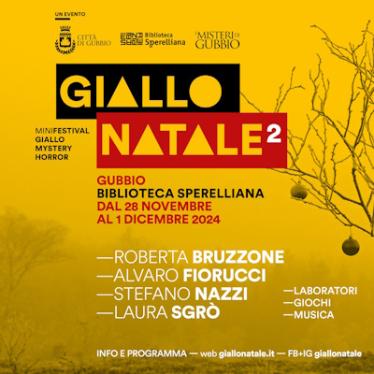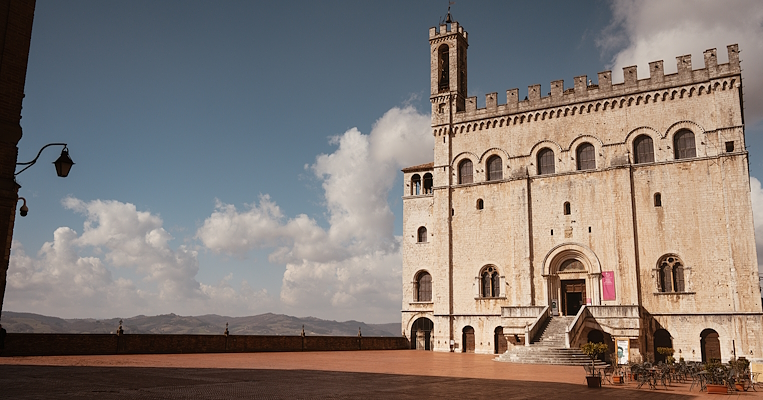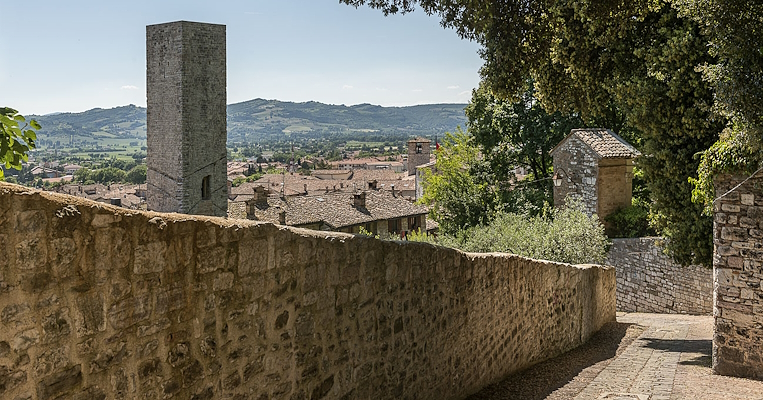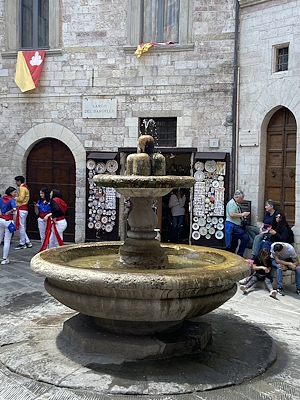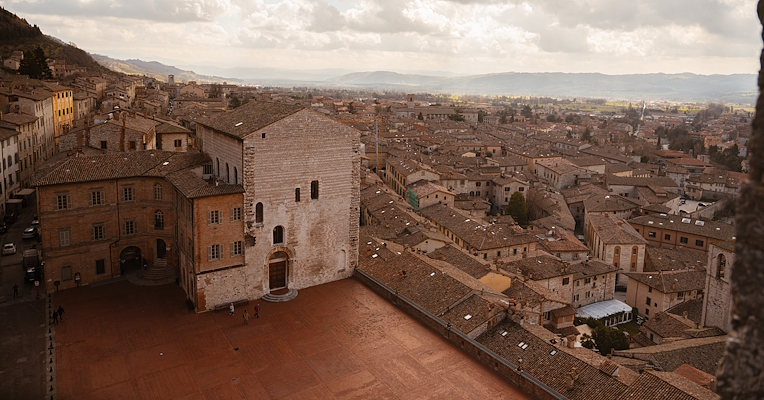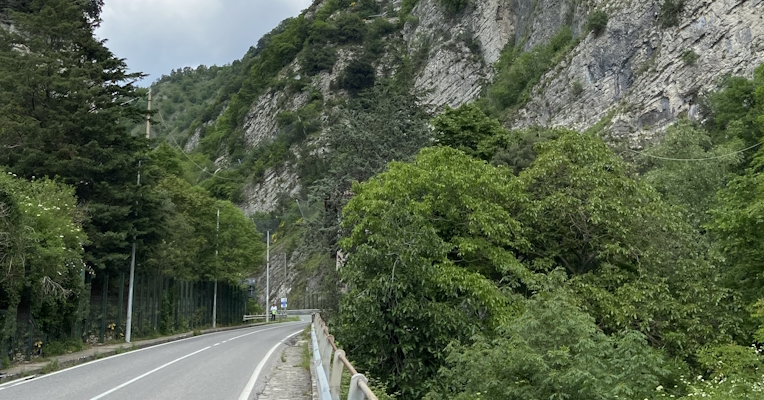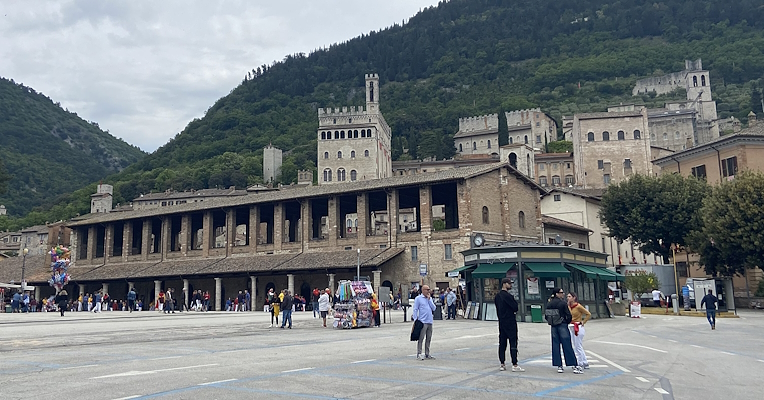Historical Overview
The ancient city of Gubbio, known as Ikuvium or Iguvium, founded by the Umbrians at the foot of Mount Ingino, was one of the most important centers of ancient Umbria. During Augustus' division in the 1st century BC, Umbria was limited to the west by the Tiber and extended eastward to the Adriatic. The precious Iguvine Tablets (3rd - 1st century BC), seven bronze tablets inscribed in the Umbrian language with extensive descriptions of religious rites and indications about the city's organization, are the most important testimony of the ancient Umbrians. Discovered in 1444 by a peasant woman near the Roman Theater, they were later acquired by the Municipality in 1456 through a notarial deed and are now preserved in the Palazzo dei Consoli.
In 90 BC, it became a Roman municipality, but as early as the 3rd century BC, Gubbio had entered into agreements with Rome for the supply of military contingents. Its proximity to the Apennine pass of Scheggia and to the Flaminia road that crosses it certainly contributed to its fortune. From the 5th century onwards, it suffered occupations and destructions (Goths, Byzantines, Lombards), and in the 12th century, freeing itself from the bishop's authority, it established a municipal self-government. From 1262 to 1350, it experienced a long period of peace and prosperity, with significant urban development including the walls and the imposing Municipal Palaces.
In 1384, after thirty years of bitter internal struggles with the Church, it was occupied by the Montefeltro of Urbino, and Urbino's domination continued until 1631 with the Della Rovere. It was a golden period for the city, which flourished culturally and artistically. Economic and political decline began again with the new submission to the Papal State. In 1860, shortly after annexation to the Kingdom of Italy, Gubbio was incorporated into Umbria.
From the Roman city to Renaissance architecture, passing through Gothic palaces and medieval glimpses
The Roman city, of which numerous and important remains still exist, extended in the flat part of Gubbio at the foot of Mount Ingino. In the archaeological area of Guastuglia, coinciding with a late-Republican neighborhood, are the remains of the Roman Theatre dating back to the 2nd-1st century BC. Of the theatre, built with rusticated limestone, the arches of the lower order and some arches of the second order remain. Nearby is the Antiquarium, built on the remains of a Roman domus, now the site of a permanent exhibition illustrating the development of the city and its territory through materials from excavations carried out. Inside, the most important room is paved with a polychrome mosaic, depicting the monster Scylla capturing Ulysses' companions.
A little further on, at Piazza Quaranta Martiri, originally the market site, the medieval city begins. Among the buildings surrounding it is the Santa Maria della Misericordia Hospital, a long building with a portico erected in 1326 and surmounted by the Logge dei Tiratori (Pullers’ lodges), so called because in the past they were used for “pulling” the cloths, meaning drying the stretched wool. Numerous churches face the square, such as the 13th-century Church of St. Francis, which seems to have been built on land owned by the Spadalonga family, who dressed St. Francis after he abandoned his family home.
From the lower part, you can climb to reach Piazza Grande, an impressive hanging terrace, where the two most important buildings of the city stand: the Palazzo del Podestà, mounted on a single central octagonal pillar supporting the cross vaults of each room, and the imposing Gothic Palazzo dei Consoli, over 60 meters high. It was built between 1332 and 1338, and now houses the Civic Museum and the Municipal Art Gallery, which hosts the famous Eugubine Tablets (3rd-1st century BC): seven bronze tablets containing the most important text in the Umbrian language, with an extensive description of religious rituals and information on the organization of the Iguvium city-state. In the slender and elegant bell tower is the great bell, called “Campanone”, dating back to 1769 and weighing over 2,000 kg. The Campanone is the voice of the city, marking the most important events of the year, starting with the Festa dei Ceri. From the terrace of Piazza Grande, you can enjoy a magnificent view of the countryside below.
About two hundred meters from the Piazza, along Via dei Consoli, you reach the 14th-century Palazzo “del Bargello”, which according to an unconfirmed tradition, was the residence of the Bargello, the magistrate in charge of the city's police service. Opposite is the eponymous fountain, also called the “fountain of the madmen”. Walking around it three times and wetting oneself with its water symbolically grants the “madman’s patent”. This ritual, dating back to the 19th century, is inspired by the “birate”, the laps made by the Ceri in Piazza Grande during the Festival.
In the upper part of the city stand, facing each other, the Cathedral of Gubbio, dedicated to Saints Marian and James, built between the 13th and 14th centuries in predominantly Gothic style, and the elegant Ducal Palace, the only example of Renaissance architecture, commissioned by Federico da Montefeltro around 1476 as a residence for his family, following the illustrious example of the one in Urbino. Inside, it preserves some original furnishings and an extraordinary replica of Federico’s studiolo (now at the Metropolitan Museum of New York), covered with inlaid wood panels based on designs by Francesco di Giorgio.
Exiting Porta Metauro, you can reach the Gola del Bottaccione (Bottaccione Gorge) on foot, carved between Monte Ingino and Monte Foce. The site has fundamental geological value because it scientifically validated the hypothesis of the impact of a huge asteroid with Earth that marked the extinction of the dinosaurs and other mammals.
Continuing on a path, you arrive at the medieval aqueduct, which from 1300 until the early 20th century brought water to Gubbio. The aqueduct, built over six hundred meters high, winds along the western slopes of Monte Ingino for about 1.6 km and reaches the upper part of the city near the first medieval settlement near the Ducal Palace.
Outside the medieval center, via a walk of about 2 km and 300 meters of ascent, by MTB, or with a cable car, you reach the Basilica of St. Ubaldo, the patron saint of Gubbio. Here are kept the relics of the Saint, along with the Ceri.
Not far away, on the rocky slopes of Monte Foce, is the Hermitage of St. Ambrose, built in 1311 by the Eugubine bishop Pietro Gabrielli, who brought the scattered hermits there and gave them the rule of St. Augustine.
Events in Gubbio
The most important historical event in Gubbio is undoubtedly the Festa dei Ceri, one of the oldest Italian folk festivals, which has been repeated every year since 1165, on May 15th, in honor of Saint Ubaldo. An event that attracts visitors from all over the world for the powerful emotions it evokes. And again, according to medieval traditions, to fully experience the spirit of Gubbio, during the Easter period, don't miss the suggestive Procession of the Dead Christ, which dates back to the distant 13th century. During the Christmas season, instead, you can admire an unprecedented spectacle thanks to the Largest Christmas Tree in the World.
How to Get There
The village can be reached by car via the A14 Adriatica Motorway exiting at Fano if coming from Northern Italy or exiting at Ancona – Nord if coming from Southern Italy. Alternatively, you can choose the A1 del Sole Motorway with exits at Arezzo if coming from Northern Italy, or at Orte if coming from Southern Italy. Gubbio can also be reached by train with the Rome – Ancona railway line, or the Florence – Terontola – Perugia line, getting off at the "Fossato di Vico-Gubbio" station.


























